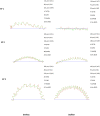A New Approach of Sperm Motility Subpopulation Structure in Donkey and Horse
- PMID: 34113670
- PMCID: PMC8186528
- DOI: 10.3389/fvets.2021.651477
A New Approach of Sperm Motility Subpopulation Structure in Donkey and Horse
Abstract
This study aimed to characterize the sperm kinematic values with high frames per second, to define the subpopulation structure of a horse and a donkey and compare them. A total of 57 fresh semen ejaculates (26 Spanish and 16 Arabian horse breeds and 10 donkeys) were collected and subsequently analyzed for kinematic parameters using the Computer-aided sperm motility analysis ISAS®v1.2 system and using a Spermtrack® 10-μm depth counting chamber. Sequences were recorded at 250 frames per second, and eight kinematic parameters were automatically evaluated. All kinematic parameters showed significant differences between a donkey and a horse and between horse breeds. All ejaculates evaluated showed excellent semen motility characteristics, with significantly higher values for all kinematic parameters for donkeys compared with horses except for beat-cross frequency. Donkey sperm was faster and linear than the horse. Regarding horse breeds differences, the Spanish horse had higher average path velocity, curvilinear velocity, and beat-cross frequency compared with the Arabian horse. Spanish horse sperm was rapid, but Arab horse was more linear. The principal component analysis showed three sperm subpopulations in the ejaculate of donkeys and horses with a significantly different motility characteristic between them. The dominant subpopulation for both donkey and horse was for rapid, straight, and linear with a high beat sperm (38.2 and 41.7%, respectively), whereas the lowest subpopulation was for the slowest and non-linear sperms. This, plus slight differences in the distribution of these subpopulations between Arabian and Spanish horses, were found. In conclusion, higher frames permitted to have a new interpretation of motile subpopulations with species and breed differences. More so, future works on donkey and horse breed spermatozoa should take into account differences between breeds that may interfere and alter the real analysis performed.
Keywords: CASA-mot; equids; sperm kinematics; sperm motility; subpopulations.
Copyright © 2021 Gacem, Valverde, Catalán, Yánez Ortiz, Soler and Miró.
Conflict of interest statement
The authors declare that the research was conducted in the absence of any commercial or financial relationships that could be construed as a potential conflict of interest.
Figures

Similar articles
-
Sperm motility patterns in Andalusian donkey (Equus asinus) semen: effects of body weight, age, and semen quality.Theriogenology. 2013 Apr 15;79(7):1100-9. doi: 10.1016/j.theriogenology.2013.02.006. Epub 2013 Mar 6. Theriogenology. 2013. PMID: 23473870
-
Effect of frame rate capture frequency on sperm kinematic parameters and subpopulation structure definition in boars, analysed with a CASA-Mot system.Reprod Domest Anim. 2019 Feb;54(2):167-175. doi: 10.1111/rda.13320. Epub 2018 Sep 29. Reprod Domest Anim. 2019. PMID: 30171651
-
Optimization of CASA-Mot Analysis of Donkey Sperm: Optimum Frame Rate and Values of Kinematic Variables for Different Counting Chamber and Fields.Animals (Basel). 2020 Oct 29;10(11):1993. doi: 10.3390/ani10111993. Animals (Basel). 2020. PMID: 33138237 Free PMC article.
-
Sperm motility patterns and metabolism in Catalonian donkey semen.Theriogenology. 2005 Apr 1;63(6):1706-16. doi: 10.1016/j.theriogenology.2004.07.022. Theriogenology. 2005. PMID: 15763113
-
Clinical Aspects of Bacterial Distribution and Antibiotic Resistance in the Reproductive System of Equids.Antibiotics (Basel). 2023 Mar 28;12(4):664. doi: 10.3390/antibiotics12040664. Antibiotics (Basel). 2023. PMID: 37107026 Free PMC article. Review.
Cited by
-
Sustainable Alternatives to the Reduction of Plastic Straws Used with Chilled Equine Semen.Animals (Basel). 2024 Nov 25;14(23):3388. doi: 10.3390/ani14233388. Animals (Basel). 2024. PMID: 39682354 Free PMC article.
-
Current and Emerging Advanced Techniques for Breeding Donkeys and Mules.Animals (Basel). 2025 Mar 29;15(7):990. doi: 10.3390/ani15070990. Animals (Basel). 2025. PMID: 40218383 Free PMC article. Review.
-
Comprehensive Integrated Analyses of Proteins and Metabolites in Equine Seminal Plasma (Horses and Donkeys).Proteomes. 2025 Jul 4;13(3):33. doi: 10.3390/proteomes13030033. Proteomes. 2025. PMID: 40700277 Free PMC article.
-
Spermiogram, Kinetics, Flow Cytometric Characteristics and DNA Damage Degree in Boar Ejaculates: Summarization and Clustering.Vet Sci. 2024 Sep 9;11(9):420. doi: 10.3390/vetsci11090420. Vet Sci. 2024. PMID: 39330799 Free PMC article.
-
ProAKAP4 as Indicator of Long-Lasting Motility Marker in Post-Thaw Conditions in Stallions.Animals (Basel). 2024 Apr 23;14(9):1264. doi: 10.3390/ani14091264. Animals (Basel). 2024. PMID: 38731267 Free PMC article.
References
-
- Zeder MA, Bradley DG, Emshwiller E, Smith BD. Documenting Domestication: New Genetic and Archaeological Paradigms. Oakland, CA: University of California Press; (2006). 10.1525/9780520932425 - DOI
-
- Clutton-Brock J. Horse Power: A History of the Horse and the Donkey in Human Societies. Cambridge, MA: Harvard University Press; (1992).
LinkOut - more resources
Full Text Sources

